Integrating EIA and EMS for Enhanced Project Development
VerifiedAdded on 2023/06/05
|17
|4846
|363
Report
AI Summary
This report explores the integration of Environmental Impact Assessment (EIA) and Environmental Management Systems (EMS) in project development, highlighting their importance in managing environmental impacts and promoting sustainability. It begins by comparing EIA and EMS, detailing their individual processes, strengths, and weaknesses, with a focus on the ISO 14001 standards for environmental management. The report then presents an integrated EIA-EMS model for infrastructure projects, covering stages from screening and scoping to implementation, operation, and management review, emphasizing the driving factors for successful integration. The analysis includes an activity impact model to illustrate the practical application of the integrated framework. The report concludes by reinforcing the necessity of these tools in sustainable growth and evaluating their effectiveness in mitigating anthropogenic impacts, advocating for a cohesive approach to environmental management in project development. Desklib provides access to similar solved assignments and past papers for further study.
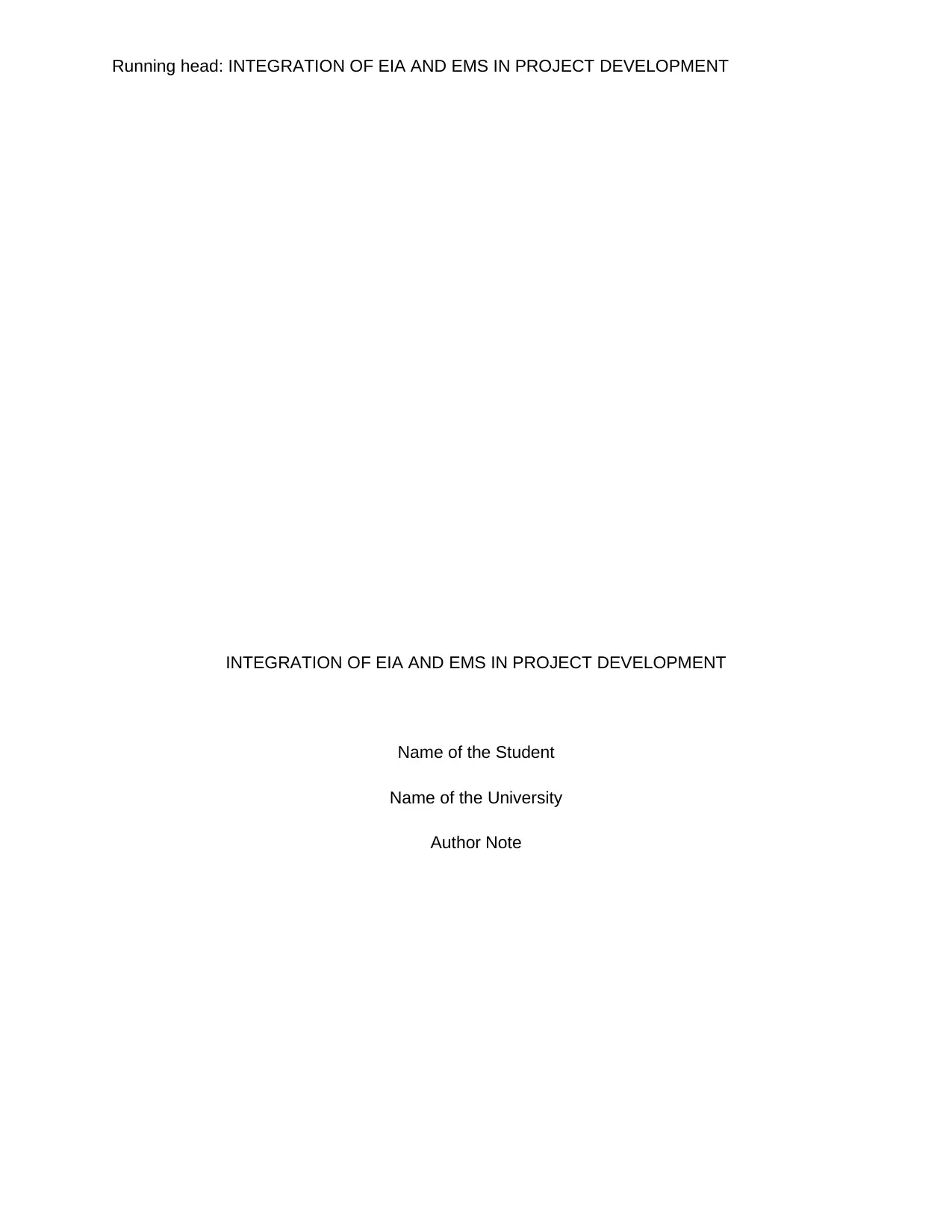
Running head: INTEGRATION OF EIA AND EMS IN PROJECT DEVELOPMENT
INTEGRATION OF EIA AND EMS IN PROJECT DEVELOPMENT
Name of the Student
Name of the University
Author Note
INTEGRATION OF EIA AND EMS IN PROJECT DEVELOPMENT
Name of the Student
Name of the University
Author Note
Paraphrase This Document
Need a fresh take? Get an instant paraphrase of this document with our AI Paraphraser
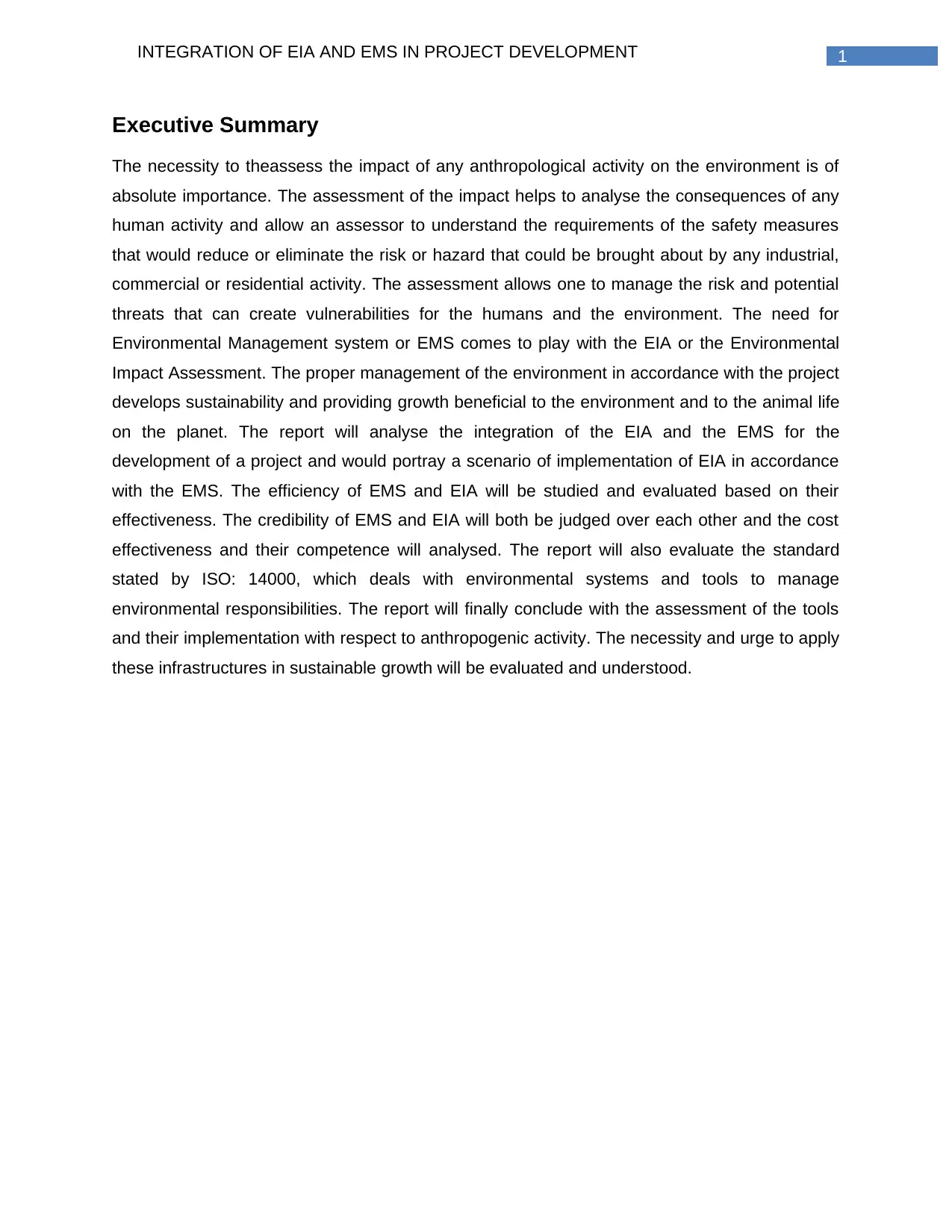
1INTEGRATION OF EIA AND EMS IN PROJECT DEVELOPMENT
Executive Summary
The necessity to theassess the impact of any anthropological activity on the environment is of
absolute importance. The assessment of the impact helps to analyse the consequences of any
human activity and allow an assessor to understand the requirements of the safety measures
that would reduce or eliminate the risk or hazard that could be brought about by any industrial,
commercial or residential activity. The assessment allows one to manage the risk and potential
threats that can create vulnerabilities for the humans and the environment. The need for
Environmental Management system or EMS comes to play with the EIA or the Environmental
Impact Assessment. The proper management of the environment in accordance with the project
develops sustainability and providing growth beneficial to the environment and to the animal life
on the planet. The report will analyse the integration of the EIA and the EMS for the
development of a project and would portray a scenario of implementation of EIA in accordance
with the EMS. The efficiency of EMS and EIA will be studied and evaluated based on their
effectiveness. The credibility of EMS and EIA will both be judged over each other and the cost
effectiveness and their competence will analysed. The report will also evaluate the standard
stated by ISO: 14000, which deals with environmental systems and tools to manage
environmental responsibilities. The report will finally conclude with the assessment of the tools
and their implementation with respect to anthropogenic activity. The necessity and urge to apply
these infrastructures in sustainable growth will be evaluated and understood.
Executive Summary
The necessity to theassess the impact of any anthropological activity on the environment is of
absolute importance. The assessment of the impact helps to analyse the consequences of any
human activity and allow an assessor to understand the requirements of the safety measures
that would reduce or eliminate the risk or hazard that could be brought about by any industrial,
commercial or residential activity. The assessment allows one to manage the risk and potential
threats that can create vulnerabilities for the humans and the environment. The need for
Environmental Management system or EMS comes to play with the EIA or the Environmental
Impact Assessment. The proper management of the environment in accordance with the project
develops sustainability and providing growth beneficial to the environment and to the animal life
on the planet. The report will analyse the integration of the EIA and the EMS for the
development of a project and would portray a scenario of implementation of EIA in accordance
with the EMS. The efficiency of EMS and EIA will be studied and evaluated based on their
effectiveness. The credibility of EMS and EIA will both be judged over each other and the cost
effectiveness and their competence will analysed. The report will also evaluate the standard
stated by ISO: 14000, which deals with environmental systems and tools to manage
environmental responsibilities. The report will finally conclude with the assessment of the tools
and their implementation with respect to anthropogenic activity. The necessity and urge to apply
these infrastructures in sustainable growth will be evaluated and understood.
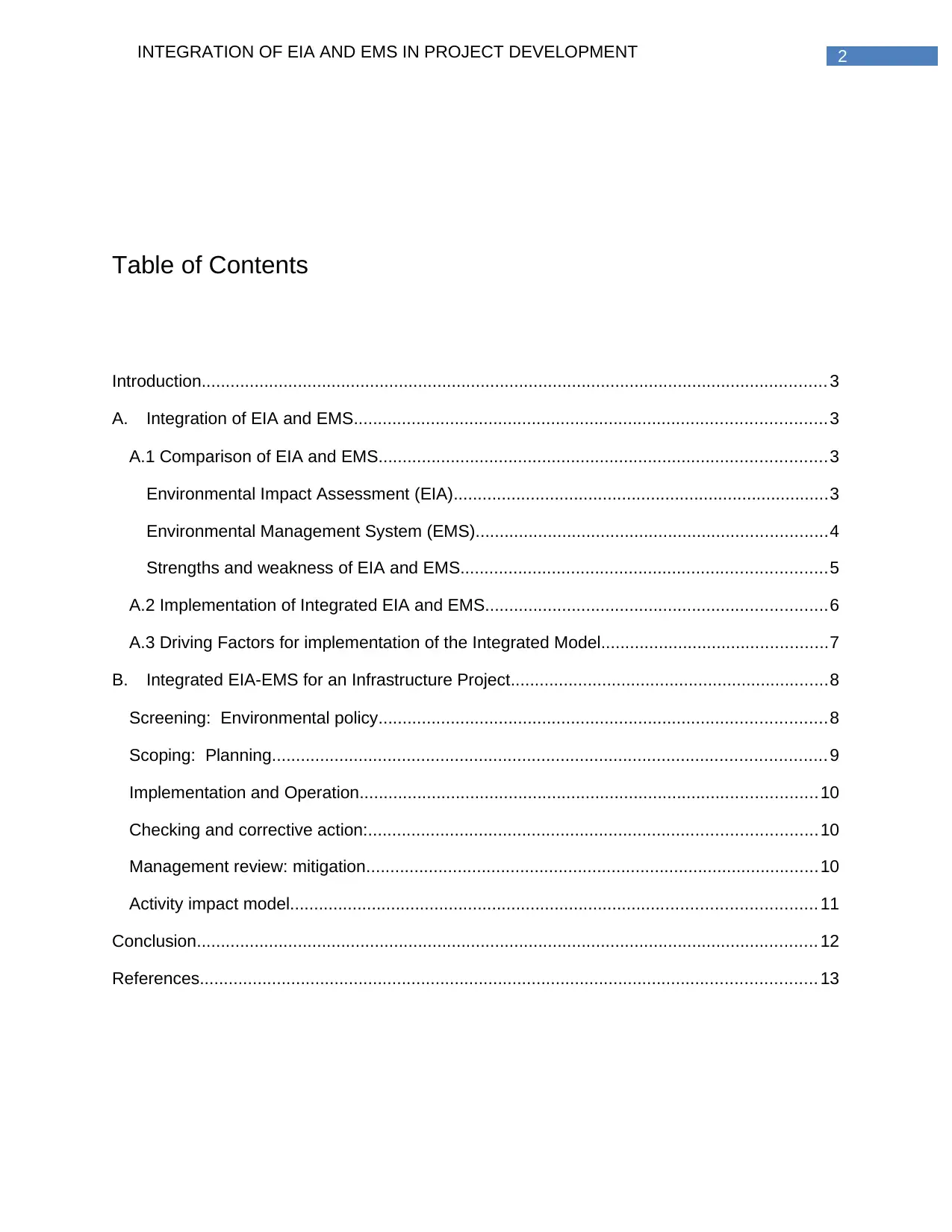
2INTEGRATION OF EIA AND EMS IN PROJECT DEVELOPMENT
Table of Contents
Introduction.................................................................................................................................. 3
A. Integration of EIA and EMS..................................................................................................3
A.1 Comparison of EIA and EMS.............................................................................................3
Environmental Impact Assessment (EIA)..............................................................................3
Environmental Management System (EMS).........................................................................4
Strengths and weakness of EIA and EMS............................................................................5
A.2 Implementation of Integrated EIA and EMS.......................................................................6
A.3 Driving Factors for implementation of the Integrated Model...............................................7
B. Integrated EIA-EMS for an Infrastructure Project..................................................................8
Screening: Environmental policy.............................................................................................8
Scoping: Planning................................................................................................................... 9
Implementation and Operation...............................................................................................10
Checking and corrective action:.............................................................................................10
Management review: mitigation..............................................................................................10
Activity impact model............................................................................................................. 11
Conclusion................................................................................................................................. 12
References................................................................................................................................ 13
Table of Contents
Introduction.................................................................................................................................. 3
A. Integration of EIA and EMS..................................................................................................3
A.1 Comparison of EIA and EMS.............................................................................................3
Environmental Impact Assessment (EIA)..............................................................................3
Environmental Management System (EMS).........................................................................4
Strengths and weakness of EIA and EMS............................................................................5
A.2 Implementation of Integrated EIA and EMS.......................................................................6
A.3 Driving Factors for implementation of the Integrated Model...............................................7
B. Integrated EIA-EMS for an Infrastructure Project..................................................................8
Screening: Environmental policy.............................................................................................8
Scoping: Planning................................................................................................................... 9
Implementation and Operation...............................................................................................10
Checking and corrective action:.............................................................................................10
Management review: mitigation..............................................................................................10
Activity impact model............................................................................................................. 11
Conclusion................................................................................................................................. 12
References................................................................................................................................ 13
⊘ This is a preview!⊘
Do you want full access?
Subscribe today to unlock all pages.

Trusted by 1+ million students worldwide
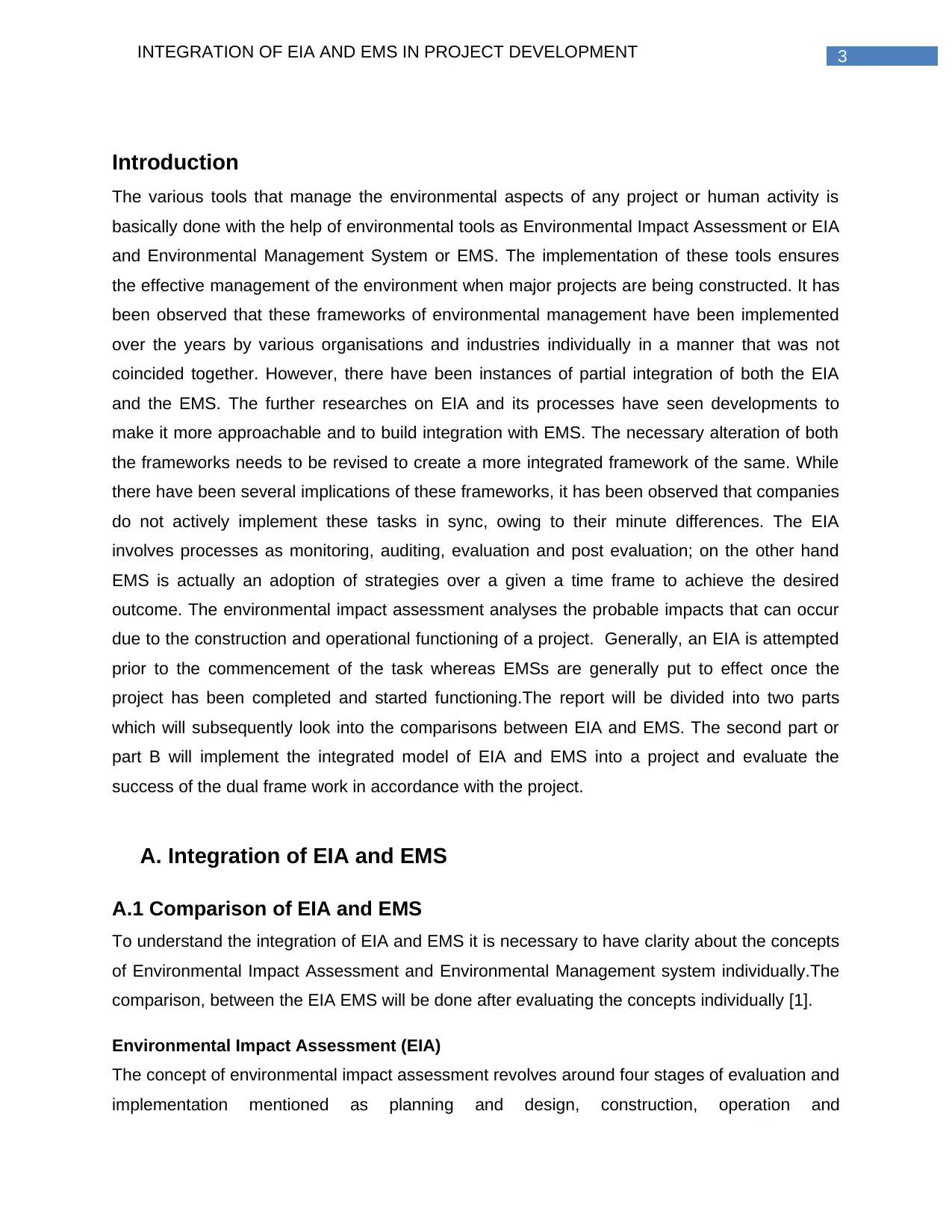
3INTEGRATION OF EIA AND EMS IN PROJECT DEVELOPMENT
Introduction
The various tools that manage the environmental aspects of any project or human activity is
basically done with the help of environmental tools as Environmental Impact Assessment or EIA
and Environmental Management System or EMS. The implementation of these tools ensures
the effective management of the environment when major projects are being constructed. It has
been observed that these frameworks of environmental management have been implemented
over the years by various organisations and industries individually in a manner that was not
coincided together. However, there have been instances of partial integration of both the EIA
and the EMS. The further researches on EIA and its processes have seen developments to
make it more approachable and to build integration with EMS. The necessary alteration of both
the frameworks needs to be revised to create a more integrated framework of the same. While
there have been several implications of these frameworks, it has been observed that companies
do not actively implement these tasks in sync, owing to their minute differences. The EIA
involves processes as monitoring, auditing, evaluation and post evaluation; on the other hand
EMS is actually an adoption of strategies over a given a time frame to achieve the desired
outcome. The environmental impact assessment analyses the probable impacts that can occur
due to the construction and operational functioning of a project. Generally, an EIA is attempted
prior to the commencement of the task whereas EMSs are generally put to effect once the
project has been completed and started functioning.The report will be divided into two parts
which will subsequently look into the comparisons between EIA and EMS. The second part or
part B will implement the integrated model of EIA and EMS into a project and evaluate the
success of the dual frame work in accordance with the project.
A. Integration of EIA and EMS
A.1 Comparison of EIA and EMS
To understand the integration of EIA and EMS it is necessary to have clarity about the concepts
of Environmental Impact Assessment and Environmental Management system individually.The
comparison, between the EIA EMS will be done after evaluating the concepts individually [1].
Environmental Impact Assessment (EIA)
The concept of environmental impact assessment revolves around four stages of evaluation and
implementation mentioned as planning and design, construction, operation and
Introduction
The various tools that manage the environmental aspects of any project or human activity is
basically done with the help of environmental tools as Environmental Impact Assessment or EIA
and Environmental Management System or EMS. The implementation of these tools ensures
the effective management of the environment when major projects are being constructed. It has
been observed that these frameworks of environmental management have been implemented
over the years by various organisations and industries individually in a manner that was not
coincided together. However, there have been instances of partial integration of both the EIA
and the EMS. The further researches on EIA and its processes have seen developments to
make it more approachable and to build integration with EMS. The necessary alteration of both
the frameworks needs to be revised to create a more integrated framework of the same. While
there have been several implications of these frameworks, it has been observed that companies
do not actively implement these tasks in sync, owing to their minute differences. The EIA
involves processes as monitoring, auditing, evaluation and post evaluation; on the other hand
EMS is actually an adoption of strategies over a given a time frame to achieve the desired
outcome. The environmental impact assessment analyses the probable impacts that can occur
due to the construction and operational functioning of a project. Generally, an EIA is attempted
prior to the commencement of the task whereas EMSs are generally put to effect once the
project has been completed and started functioning.The report will be divided into two parts
which will subsequently look into the comparisons between EIA and EMS. The second part or
part B will implement the integrated model of EIA and EMS into a project and evaluate the
success of the dual frame work in accordance with the project.
A. Integration of EIA and EMS
A.1 Comparison of EIA and EMS
To understand the integration of EIA and EMS it is necessary to have clarity about the concepts
of Environmental Impact Assessment and Environmental Management system individually.The
comparison, between the EIA EMS will be done after evaluating the concepts individually [1].
Environmental Impact Assessment (EIA)
The concept of environmental impact assessment revolves around four stages of evaluation and
implementation mentioned as planning and design, construction, operation and
Paraphrase This Document
Need a fresh take? Get an instant paraphrase of this document with our AI Paraphraser
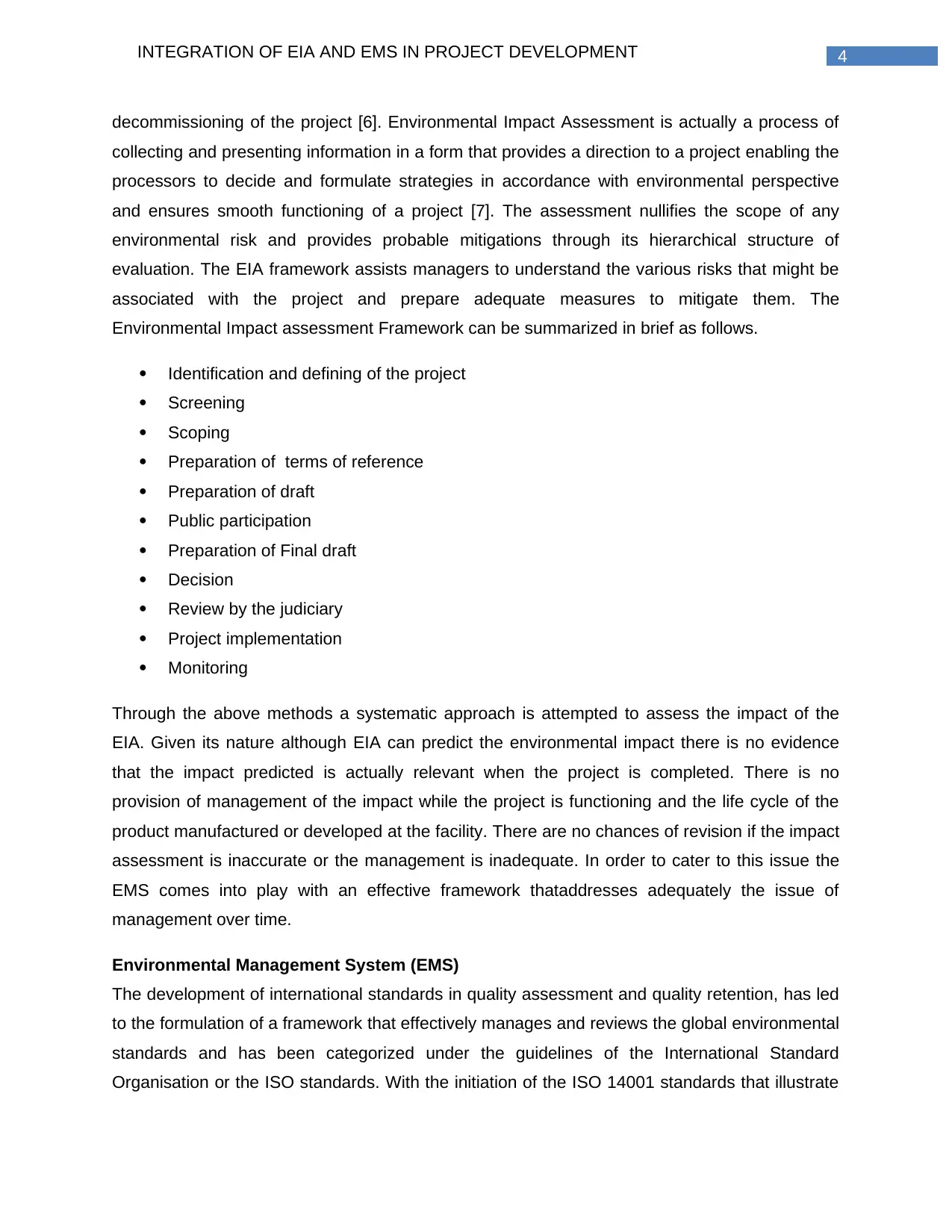
4INTEGRATION OF EIA AND EMS IN PROJECT DEVELOPMENT
decommissioning of the project [6]. Environmental Impact Assessment is actually a process of
collecting and presenting information in a form that provides a direction to a project enabling the
processors to decide and formulate strategies in accordance with environmental perspective
and ensures smooth functioning of a project [7]. The assessment nullifies the scope of any
environmental risk and provides probable mitigations through its hierarchical structure of
evaluation. The EIA framework assists managers to understand the various risks that might be
associated with the project and prepare adequate measures to mitigate them. The
Environmental Impact assessment Framework can be summarized in brief as follows.
Identification and defining of the project
Screening
Scoping
Preparation of terms of reference
Preparation of draft
Public participation
Preparation of Final draft
Decision
Review by the judiciary
Project implementation
Monitoring
Through the above methods a systematic approach is attempted to assess the impact of the
EIA. Given its nature although EIA can predict the environmental impact there is no evidence
that the impact predicted is actually relevant when the project is completed. There is no
provision of management of the impact while the project is functioning and the life cycle of the
product manufactured or developed at the facility. There are no chances of revision if the impact
assessment is inaccurate or the management is inadequate. In order to cater to this issue the
EMS comes into play with an effective framework thataddresses adequately the issue of
management over time.
Environmental Management System (EMS)
The development of international standards in quality assessment and quality retention, has led
to the formulation of a framework that effectively manages and reviews the global environmental
standards and has been categorized under the guidelines of the International Standard
Organisation or the ISO standards. With the initiation of the ISO 14001 standards that illustrate
decommissioning of the project [6]. Environmental Impact Assessment is actually a process of
collecting and presenting information in a form that provides a direction to a project enabling the
processors to decide and formulate strategies in accordance with environmental perspective
and ensures smooth functioning of a project [7]. The assessment nullifies the scope of any
environmental risk and provides probable mitigations through its hierarchical structure of
evaluation. The EIA framework assists managers to understand the various risks that might be
associated with the project and prepare adequate measures to mitigate them. The
Environmental Impact assessment Framework can be summarized in brief as follows.
Identification and defining of the project
Screening
Scoping
Preparation of terms of reference
Preparation of draft
Public participation
Preparation of Final draft
Decision
Review by the judiciary
Project implementation
Monitoring
Through the above methods a systematic approach is attempted to assess the impact of the
EIA. Given its nature although EIA can predict the environmental impact there is no evidence
that the impact predicted is actually relevant when the project is completed. There is no
provision of management of the impact while the project is functioning and the life cycle of the
product manufactured or developed at the facility. There are no chances of revision if the impact
assessment is inaccurate or the management is inadequate. In order to cater to this issue the
EMS comes into play with an effective framework thataddresses adequately the issue of
management over time.
Environmental Management System (EMS)
The development of international standards in quality assessment and quality retention, has led
to the formulation of a framework that effectively manages and reviews the global environmental
standards and has been categorized under the guidelines of the International Standard
Organisation or the ISO standards. With the initiation of the ISO 14001 standards that illustrate
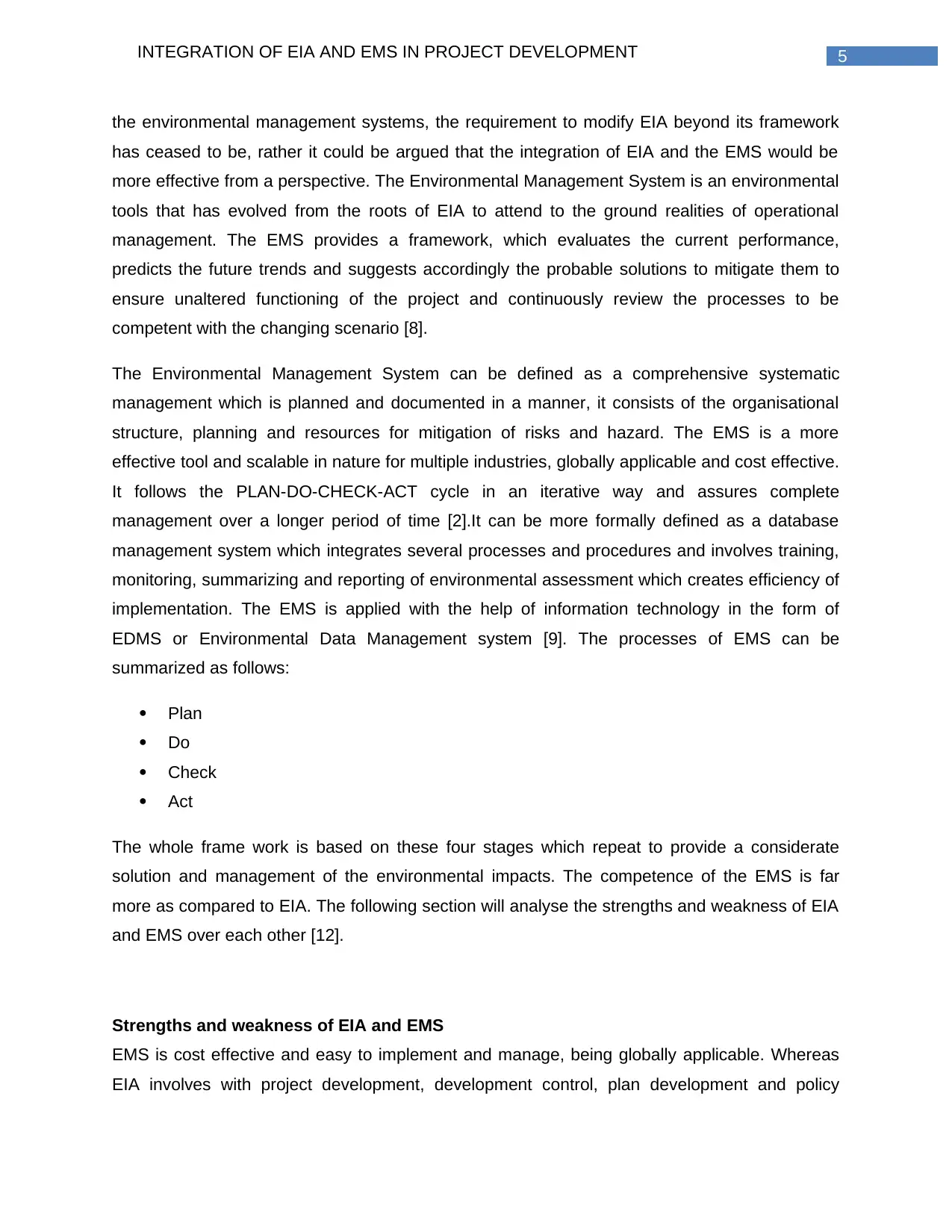
5INTEGRATION OF EIA AND EMS IN PROJECT DEVELOPMENT
the environmental management systems, the requirement to modify EIA beyond its framework
has ceased to be, rather it could be argued that the integration of EIA and the EMS would be
more effective from a perspective. The Environmental Management System is an environmental
tools that has evolved from the roots of EIA to attend to the ground realities of operational
management. The EMS provides a framework, which evaluates the current performance,
predicts the future trends and suggests accordingly the probable solutions to mitigate them to
ensure unaltered functioning of the project and continuously review the processes to be
competent with the changing scenario [8].
The Environmental Management System can be defined as a comprehensive systematic
management which is planned and documented in a manner, it consists of the organisational
structure, planning and resources for mitigation of risks and hazard. The EMS is a more
effective tool and scalable in nature for multiple industries, globally applicable and cost effective.
It follows the PLAN-DO-CHECK-ACT cycle in an iterative way and assures complete
management over a longer period of time [2].It can be more formally defined as a database
management system which integrates several processes and procedures and involves training,
monitoring, summarizing and reporting of environmental assessment which creates efficiency of
implementation. The EMS is applied with the help of information technology in the form of
EDMS or Environmental Data Management system [9]. The processes of EMS can be
summarized as follows:
Plan
Do
Check
Act
The whole frame work is based on these four stages which repeat to provide a considerate
solution and management of the environmental impacts. The competence of the EMS is far
more as compared to EIA. The following section will analyse the strengths and weakness of EIA
and EMS over each other [12].
Strengths and weakness of EIA and EMS
EMS is cost effective and easy to implement and manage, being globally applicable. Whereas
EIA involves with project development, development control, plan development and policy
the environmental management systems, the requirement to modify EIA beyond its framework
has ceased to be, rather it could be argued that the integration of EIA and the EMS would be
more effective from a perspective. The Environmental Management System is an environmental
tools that has evolved from the roots of EIA to attend to the ground realities of operational
management. The EMS provides a framework, which evaluates the current performance,
predicts the future trends and suggests accordingly the probable solutions to mitigate them to
ensure unaltered functioning of the project and continuously review the processes to be
competent with the changing scenario [8].
The Environmental Management System can be defined as a comprehensive systematic
management which is planned and documented in a manner, it consists of the organisational
structure, planning and resources for mitigation of risks and hazard. The EMS is a more
effective tool and scalable in nature for multiple industries, globally applicable and cost effective.
It follows the PLAN-DO-CHECK-ACT cycle in an iterative way and assures complete
management over a longer period of time [2].It can be more formally defined as a database
management system which integrates several processes and procedures and involves training,
monitoring, summarizing and reporting of environmental assessment which creates efficiency of
implementation. The EMS is applied with the help of information technology in the form of
EDMS or Environmental Data Management system [9]. The processes of EMS can be
summarized as follows:
Plan
Do
Check
Act
The whole frame work is based on these four stages which repeat to provide a considerate
solution and management of the environmental impacts. The competence of the EMS is far
more as compared to EIA. The following section will analyse the strengths and weakness of EIA
and EMS over each other [12].
Strengths and weakness of EIA and EMS
EMS is cost effective and easy to implement and manage, being globally applicable. Whereas
EIA involves with project development, development control, plan development and policy
⊘ This is a preview!⊘
Do you want full access?
Subscribe today to unlock all pages.

Trusted by 1+ million students worldwide
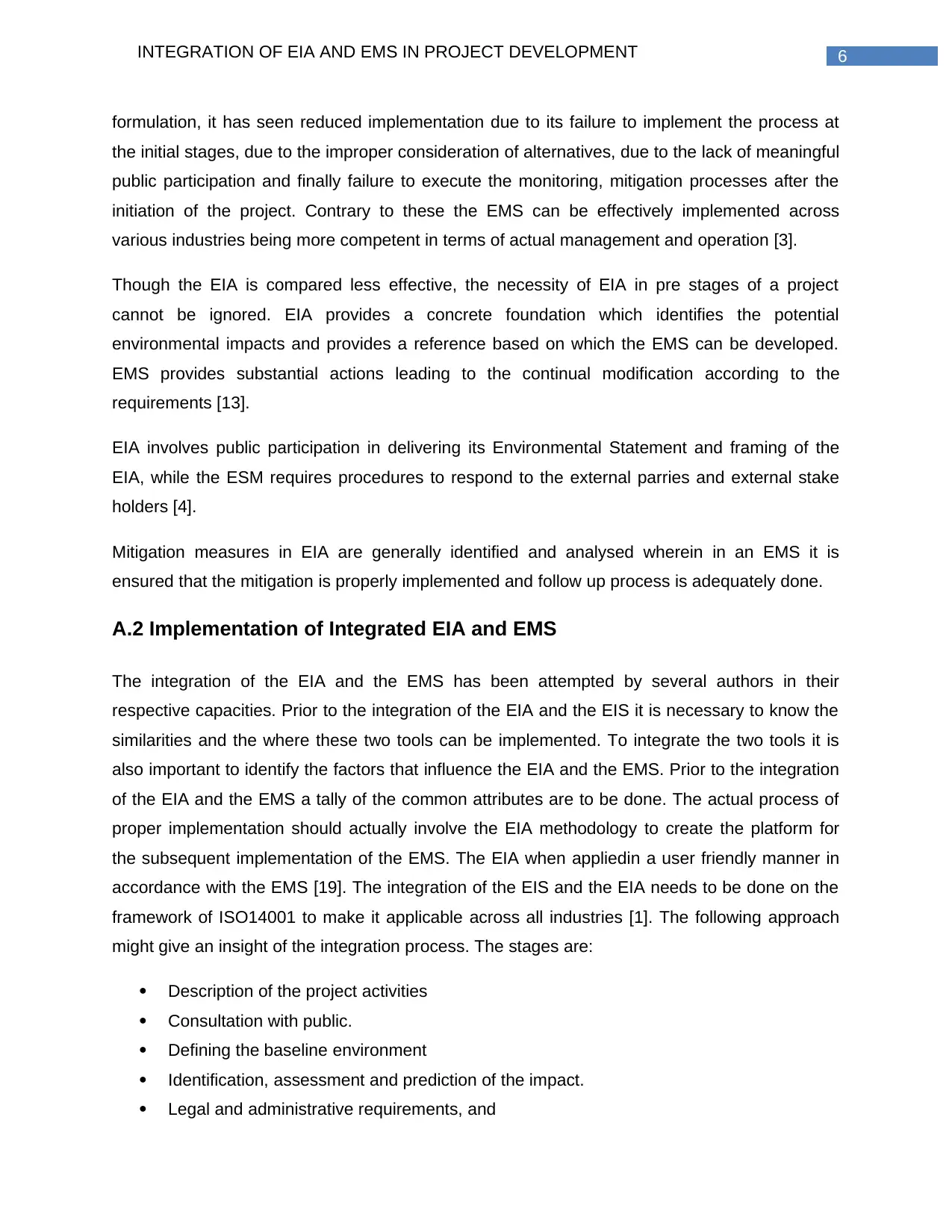
6INTEGRATION OF EIA AND EMS IN PROJECT DEVELOPMENT
formulation, it has seen reduced implementation due to its failure to implement the process at
the initial stages, due to the improper consideration of alternatives, due to the lack of meaningful
public participation and finally failure to execute the monitoring, mitigation processes after the
initiation of the project. Contrary to these the EMS can be effectively implemented across
various industries being more competent in terms of actual management and operation [3].
Though the EIA is compared less effective, the necessity of EIA in pre stages of a project
cannot be ignored. EIA provides a concrete foundation which identifies the potential
environmental impacts and provides a reference based on which the EMS can be developed.
EMS provides substantial actions leading to the continual modification according to the
requirements [13].
EIA involves public participation in delivering its Environmental Statement and framing of the
EIA, while the ESM requires procedures to respond to the external parries and external stake
holders [4].
Mitigation measures in EIA are generally identified and analysed wherein in an EMS it is
ensured that the mitigation is properly implemented and follow up process is adequately done.
A.2 Implementation of Integrated EIA and EMS
The integration of the EIA and the EMS has been attempted by several authors in their
respective capacities. Prior to the integration of the EIA and the EIS it is necessary to know the
similarities and the where these two tools can be implemented. To integrate the two tools it is
also important to identify the factors that influence the EIA and the EMS. Prior to the integration
of the EIA and the EMS a tally of the common attributes are to be done. The actual process of
proper implementation should actually involve the EIA methodology to create the platform for
the subsequent implementation of the EMS. The EIA when appliedin a user friendly manner in
accordance with the EMS [19]. The integration of the EIS and the EIA needs to be done on the
framework of ISO14001 to make it applicable across all industries [1]. The following approach
might give an insight of the integration process. The stages are:
Description of the project activities
Consultation with public.
Defining the baseline environment
Identification, assessment and prediction of the impact.
Legal and administrative requirements, and
formulation, it has seen reduced implementation due to its failure to implement the process at
the initial stages, due to the improper consideration of alternatives, due to the lack of meaningful
public participation and finally failure to execute the monitoring, mitigation processes after the
initiation of the project. Contrary to these the EMS can be effectively implemented across
various industries being more competent in terms of actual management and operation [3].
Though the EIA is compared less effective, the necessity of EIA in pre stages of a project
cannot be ignored. EIA provides a concrete foundation which identifies the potential
environmental impacts and provides a reference based on which the EMS can be developed.
EMS provides substantial actions leading to the continual modification according to the
requirements [13].
EIA involves public participation in delivering its Environmental Statement and framing of the
EIA, while the ESM requires procedures to respond to the external parries and external stake
holders [4].
Mitigation measures in EIA are generally identified and analysed wherein in an EMS it is
ensured that the mitigation is properly implemented and follow up process is adequately done.
A.2 Implementation of Integrated EIA and EMS
The integration of the EIA and the EMS has been attempted by several authors in their
respective capacities. Prior to the integration of the EIA and the EIS it is necessary to know the
similarities and the where these two tools can be implemented. To integrate the two tools it is
also important to identify the factors that influence the EIA and the EMS. Prior to the integration
of the EIA and the EMS a tally of the common attributes are to be done. The actual process of
proper implementation should actually involve the EIA methodology to create the platform for
the subsequent implementation of the EMS. The EIA when appliedin a user friendly manner in
accordance with the EMS [19]. The integration of the EIS and the EIA needs to be done on the
framework of ISO14001 to make it applicable across all industries [1]. The following approach
might give an insight of the integration process. The stages are:
Description of the project activities
Consultation with public.
Defining the baseline environment
Identification, assessment and prediction of the impact.
Legal and administrative requirements, and
Paraphrase This Document
Need a fresh take? Get an instant paraphrase of this document with our AI Paraphraser
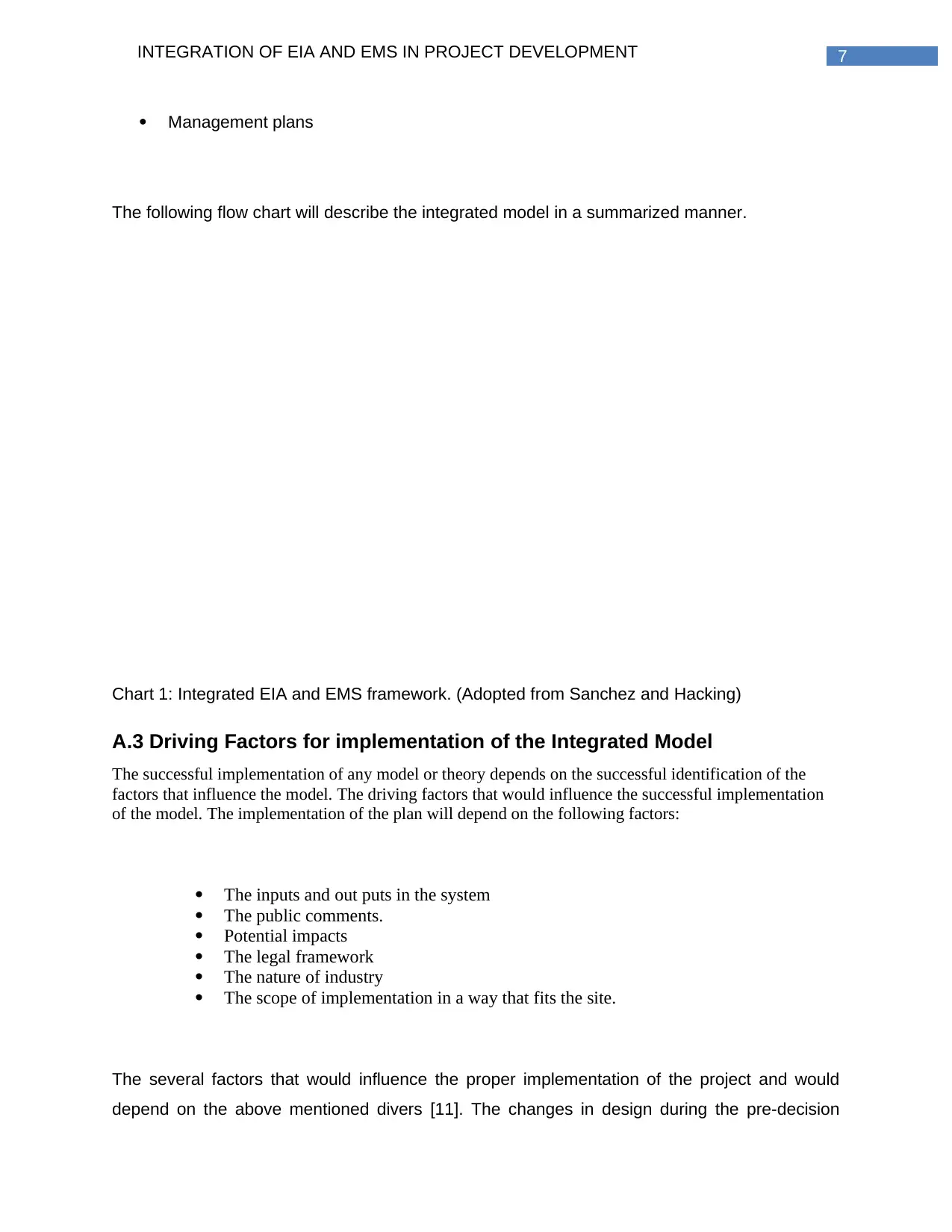
7INTEGRATION OF EIA AND EMS IN PROJECT DEVELOPMENT
Management plans
The following flow chart will describe the integrated model in a summarized manner.
Chart 1: Integrated EIA and EMS framework. (Adopted from Sanchez and Hacking)
A.3 Driving Factors for implementation of the Integrated Model
The successful implementation of any model or theory depends on the successful identification of the
factors that influence the model. The driving factors that would influence the successful implementation
of the model. The implementation of the plan will depend on the following factors:
The inputs and out puts in the system
The public comments.
Potential impacts
The legal framework
The nature of industry
The scope of implementation in a way that fits the site.
The several factors that would influence the proper implementation of the project and would
depend on the above mentioned divers [11]. The changes in design during the pre-decision
ENVIRONMENTALPOLICYPLANNINGIMPLEMENTATIONANDOPERATIONCHECKINGANDCORRECTIVEACTIONMANAGEMENTREVIEW
Management plans
The following flow chart will describe the integrated model in a summarized manner.
Chart 1: Integrated EIA and EMS framework. (Adopted from Sanchez and Hacking)
A.3 Driving Factors for implementation of the Integrated Model
The successful implementation of any model or theory depends on the successful identification of the
factors that influence the model. The driving factors that would influence the successful implementation
of the model. The implementation of the plan will depend on the following factors:
The inputs and out puts in the system
The public comments.
Potential impacts
The legal framework
The nature of industry
The scope of implementation in a way that fits the site.
The several factors that would influence the proper implementation of the project and would
depend on the above mentioned divers [11]. The changes in design during the pre-decision
ENVIRONMENTALPOLICYPLANNINGIMPLEMENTATIONANDOPERATIONCHECKINGANDCORRECTIVEACTIONMANAGEMENTREVIEW
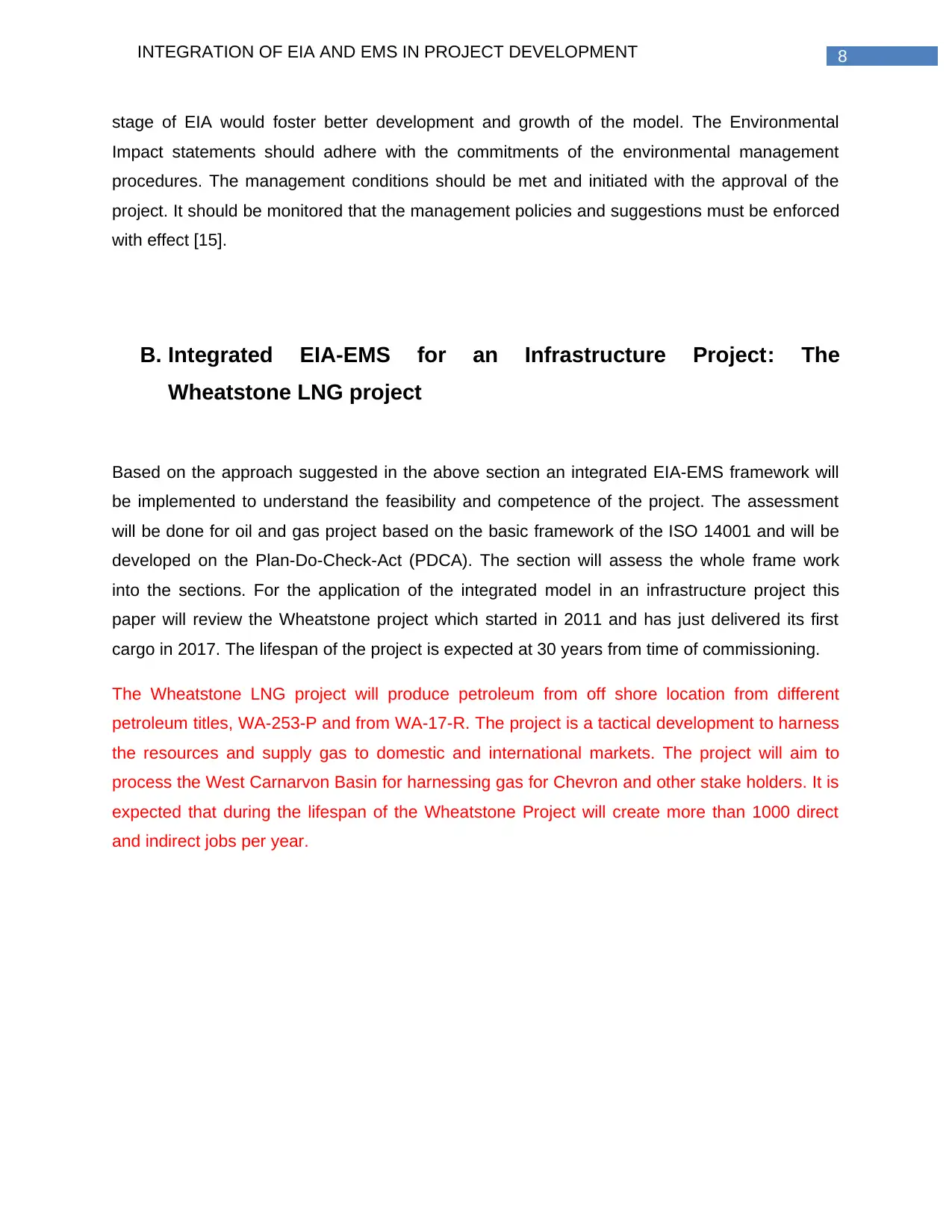
8INTEGRATION OF EIA AND EMS IN PROJECT DEVELOPMENT
stage of EIA would foster better development and growth of the model. The Environmental
Impact statements should adhere with the commitments of the environmental management
procedures. The management conditions should be met and initiated with the approval of the
project. It should be monitored that the management policies and suggestions must be enforced
with effect [15].
B. Integrated EIA-EMS for an Infrastructure Project: The
Wheatstone LNG project
Based on the approach suggested in the above section an integrated EIA-EMS framework will
be implemented to understand the feasibility and competence of the project. The assessment
will be done for oil and gas project based on the basic framework of the ISO 14001 and will be
developed on the Plan-Do-Check-Act (PDCA). The section will assess the whole frame work
into the sections. For the application of the integrated model in an infrastructure project this
paper will review the Wheatstone project which started in 2011 and has just delivered its first
cargo in 2017. The lifespan of the project is expected at 30 years from time of commissioning.
The Wheatstone LNG project will produce petroleum from off shore location from different
petroleum titles, WA-253-P and from WA-17-R. The project is a tactical development to harness
the resources and supply gas to domestic and international markets. The project will aim to
process the West Carnarvon Basin for harnessing gas for Chevron and other stake holders. It is
expected that during the lifespan of the Wheatstone Project will create more than 1000 direct
and indirect jobs per year.
stage of EIA would foster better development and growth of the model. The Environmental
Impact statements should adhere with the commitments of the environmental management
procedures. The management conditions should be met and initiated with the approval of the
project. It should be monitored that the management policies and suggestions must be enforced
with effect [15].
B. Integrated EIA-EMS for an Infrastructure Project: The
Wheatstone LNG project
Based on the approach suggested in the above section an integrated EIA-EMS framework will
be implemented to understand the feasibility and competence of the project. The assessment
will be done for oil and gas project based on the basic framework of the ISO 14001 and will be
developed on the Plan-Do-Check-Act (PDCA). The section will assess the whole frame work
into the sections. For the application of the integrated model in an infrastructure project this
paper will review the Wheatstone project which started in 2011 and has just delivered its first
cargo in 2017. The lifespan of the project is expected at 30 years from time of commissioning.
The Wheatstone LNG project will produce petroleum from off shore location from different
petroleum titles, WA-253-P and from WA-17-R. The project is a tactical development to harness
the resources and supply gas to domestic and international markets. The project will aim to
process the West Carnarvon Basin for harnessing gas for Chevron and other stake holders. It is
expected that during the lifespan of the Wheatstone Project will create more than 1000 direct
and indirect jobs per year.
⊘ This is a preview!⊘
Do you want full access?
Subscribe today to unlock all pages.

Trusted by 1+ million students worldwide
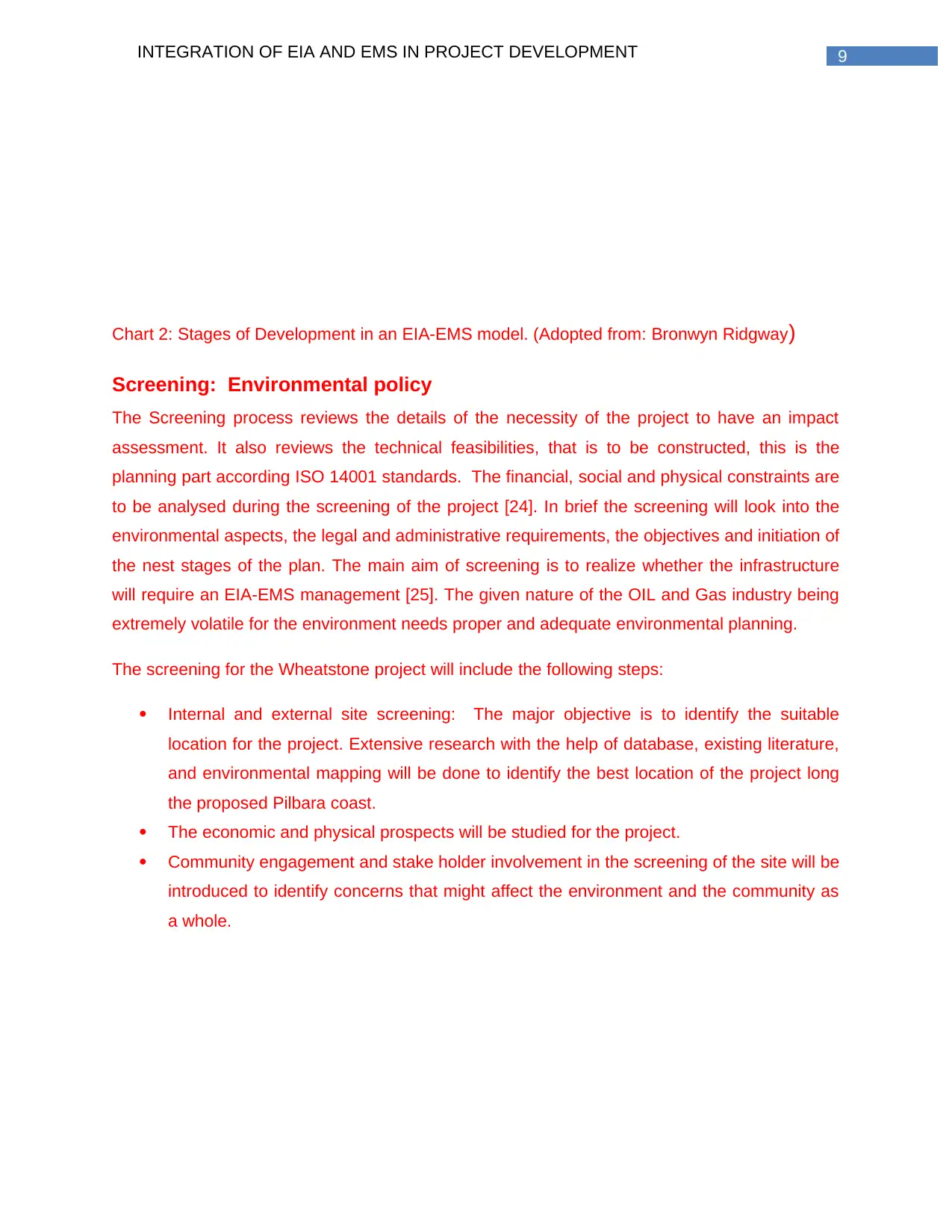
9INTEGRATION OF EIA AND EMS IN PROJECT DEVELOPMENT
Chart 2: Stages of Development in an EIA-EMS model. (Adopted from: Bronwyn Ridgway)
Screening: Environmental policy
The Screening process reviews the details of the necessity of the project to have an impact
assessment. It also reviews the technical feasibilities, that is to be constructed, this is the
planning part according ISO 14001 standards. The financial, social and physical constraints are
to be analysed during the screening of the project [24]. In brief the screening will look into the
environmental aspects, the legal and administrative requirements, the objectives and initiation of
the nest stages of the plan. The main aim of screening is to realize whether the infrastructure
will require an EIA-EMS management [25]. The given nature of the OIL and Gas industry being
extremely volatile for the environment needs proper and adequate environmental planning.
The screening for the Wheatstone project will include the following steps:
Internal and external site screening: The major objective is to identify the suitable
location for the project. Extensive research with the help of database, existing literature,
and environmental mapping will be done to identify the best location of the project long
the proposed Pilbara coast.
The economic and physical prospects will be studied for the project.
Community engagement and stake holder involvement in the screening of the site will be
introduced to identify concerns that might affect the environment and the community as
a whole.
EnvironmentalPolicyScreeningPlanningScopingIMPLEMENTATIONANDOPERATIONImpactAnalysisCheckingandCorrectiveActionCheckingManagementreviewMitigation
Chart 2: Stages of Development in an EIA-EMS model. (Adopted from: Bronwyn Ridgway)
Screening: Environmental policy
The Screening process reviews the details of the necessity of the project to have an impact
assessment. It also reviews the technical feasibilities, that is to be constructed, this is the
planning part according ISO 14001 standards. The financial, social and physical constraints are
to be analysed during the screening of the project [24]. In brief the screening will look into the
environmental aspects, the legal and administrative requirements, the objectives and initiation of
the nest stages of the plan. The main aim of screening is to realize whether the infrastructure
will require an EIA-EMS management [25]. The given nature of the OIL and Gas industry being
extremely volatile for the environment needs proper and adequate environmental planning.
The screening for the Wheatstone project will include the following steps:
Internal and external site screening: The major objective is to identify the suitable
location for the project. Extensive research with the help of database, existing literature,
and environmental mapping will be done to identify the best location of the project long
the proposed Pilbara coast.
The economic and physical prospects will be studied for the project.
Community engagement and stake holder involvement in the screening of the site will be
introduced to identify concerns that might affect the environment and the community as
a whole.
EnvironmentalPolicyScreeningPlanningScopingIMPLEMENTATIONANDOPERATIONImpactAnalysisCheckingandCorrectiveActionCheckingManagementreviewMitigation
Paraphrase This Document
Need a fresh take? Get an instant paraphrase of this document with our AI Paraphraser
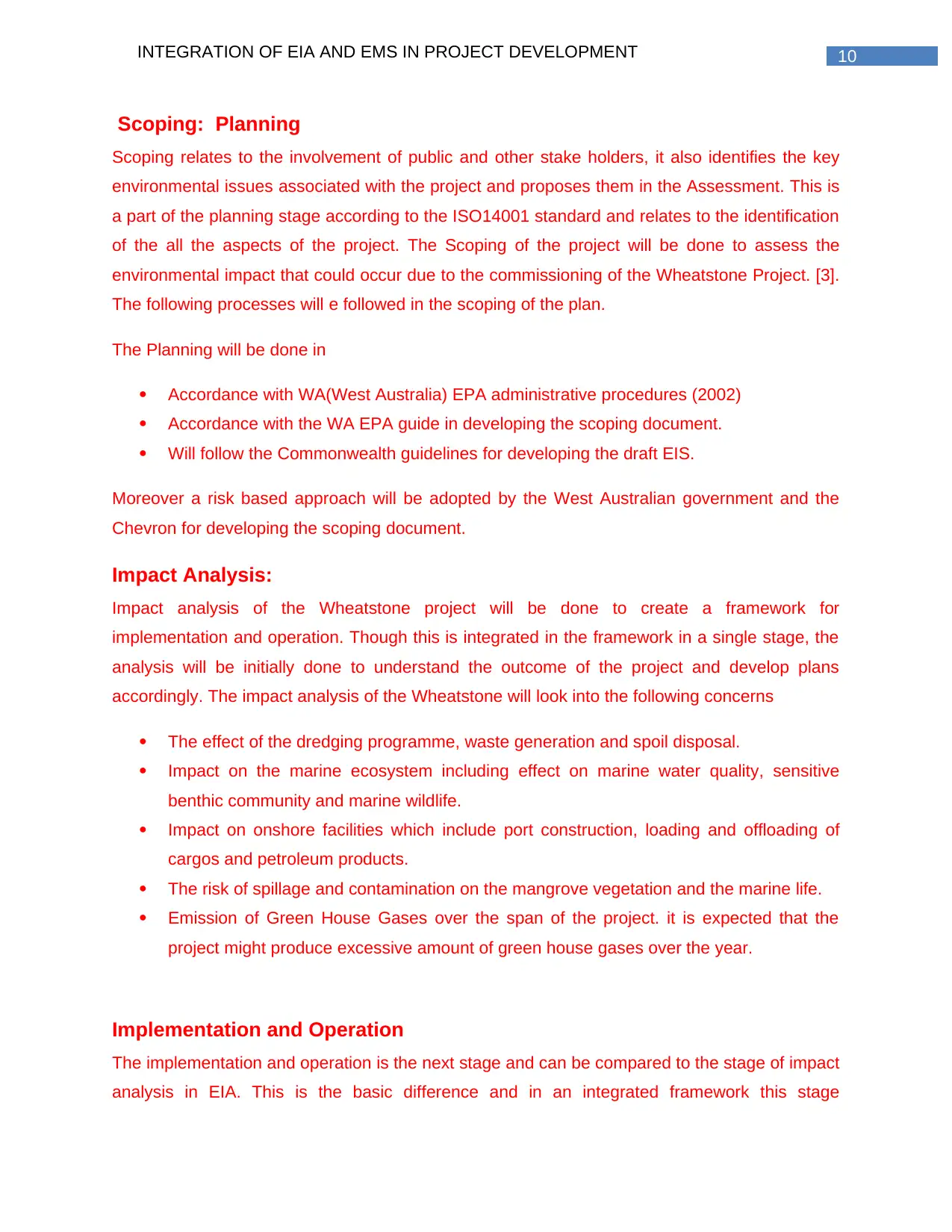
10INTEGRATION OF EIA AND EMS IN PROJECT DEVELOPMENT
Scoping: Planning
Scoping relates to the involvement of public and other stake holders, it also identifies the key
environmental issues associated with the project and proposes them in the Assessment. This is
a part of the planning stage according to the ISO14001 standard and relates to the identification
of the all the aspects of the project. The Scoping of the project will be done to assess the
environmental impact that could occur due to the commissioning of the Wheatstone Project. [3].
The following processes will e followed in the scoping of the plan.
The Planning will be done in
Accordance with WA(West Australia) EPA administrative procedures (2002)
Accordance with the WA EPA guide in developing the scoping document.
Will follow the Commonwealth guidelines for developing the draft EIS.
Moreover a risk based approach will be adopted by the West Australian government and the
Chevron for developing the scoping document.
Impact Analysis:
Impact analysis of the Wheatstone project will be done to create a framework for
implementation and operation. Though this is integrated in the framework in a single stage, the
analysis will be initially done to understand the outcome of the project and develop plans
accordingly. The impact analysis of the Wheatstone will look into the following concerns
The effect of the dredging programme, waste generation and spoil disposal.
Impact on the marine ecosystem including effect on marine water quality, sensitive
benthic community and marine wildlife.
Impact on onshore facilities which include port construction, loading and offloading of
cargos and petroleum products.
The risk of spillage and contamination on the mangrove vegetation and the marine life.
Emission of Green House Gases over the span of the project. it is expected that the
project might produce excessive amount of green house gases over the year.
Implementation and Operation
The implementation and operation is the next stage and can be compared to the stage of impact
analysis in EIA. This is the basic difference and in an integrated framework this stage
Scoping: Planning
Scoping relates to the involvement of public and other stake holders, it also identifies the key
environmental issues associated with the project and proposes them in the Assessment. This is
a part of the planning stage according to the ISO14001 standard and relates to the identification
of the all the aspects of the project. The Scoping of the project will be done to assess the
environmental impact that could occur due to the commissioning of the Wheatstone Project. [3].
The following processes will e followed in the scoping of the plan.
The Planning will be done in
Accordance with WA(West Australia) EPA administrative procedures (2002)
Accordance with the WA EPA guide in developing the scoping document.
Will follow the Commonwealth guidelines for developing the draft EIS.
Moreover a risk based approach will be adopted by the West Australian government and the
Chevron for developing the scoping document.
Impact Analysis:
Impact analysis of the Wheatstone project will be done to create a framework for
implementation and operation. Though this is integrated in the framework in a single stage, the
analysis will be initially done to understand the outcome of the project and develop plans
accordingly. The impact analysis of the Wheatstone will look into the following concerns
The effect of the dredging programme, waste generation and spoil disposal.
Impact on the marine ecosystem including effect on marine water quality, sensitive
benthic community and marine wildlife.
Impact on onshore facilities which include port construction, loading and offloading of
cargos and petroleum products.
The risk of spillage and contamination on the mangrove vegetation and the marine life.
Emission of Green House Gases over the span of the project. it is expected that the
project might produce excessive amount of green house gases over the year.
Implementation and Operation
The implementation and operation is the next stage and can be compared to the stage of impact
analysis in EIA. This is the basic difference and in an integrated framework this stage
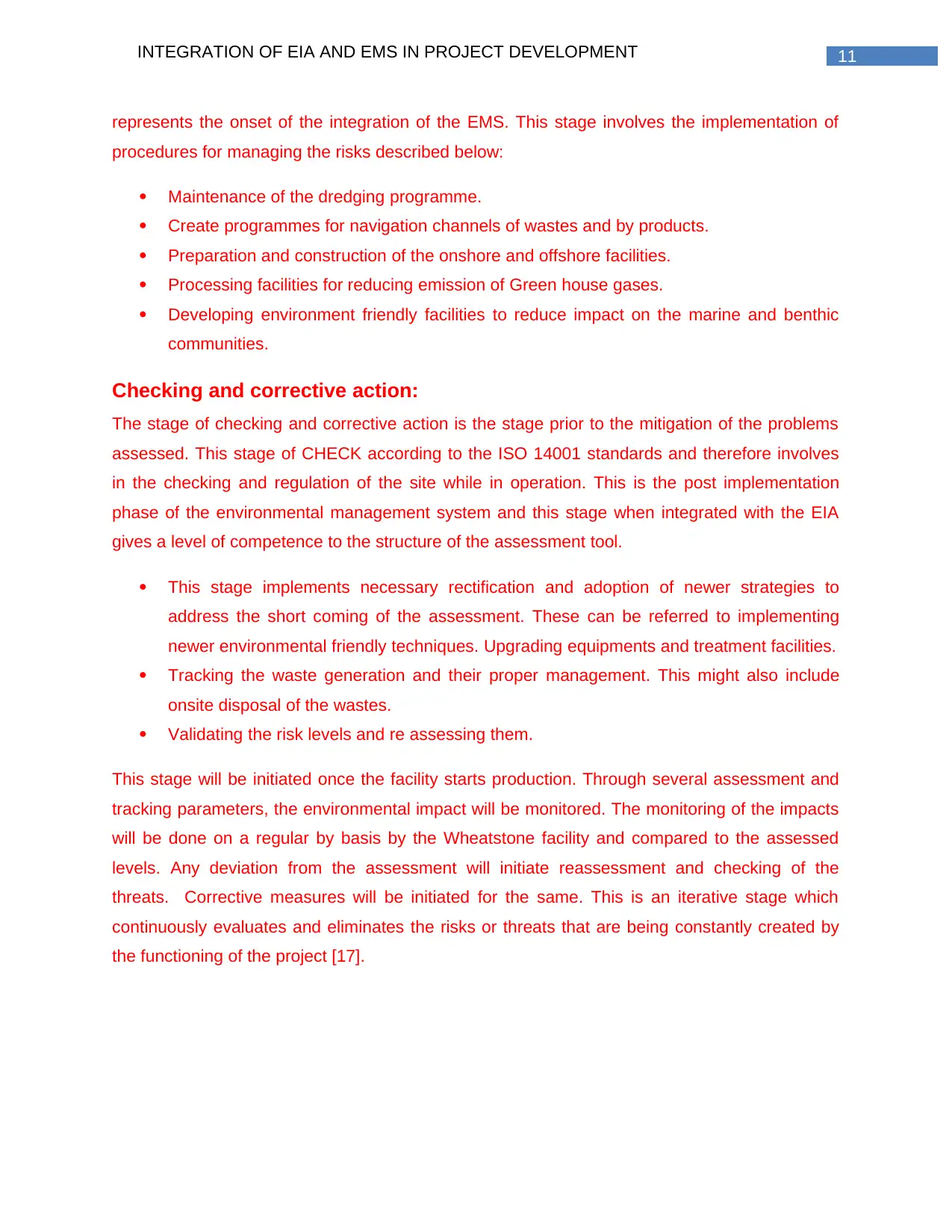
11INTEGRATION OF EIA AND EMS IN PROJECT DEVELOPMENT
represents the onset of the integration of the EMS. This stage involves the implementation of
procedures for managing the risks described below:
Maintenance of the dredging programme.
Create programmes for navigation channels of wastes and by products.
Preparation and construction of the onshore and offshore facilities.
Processing facilities for reducing emission of Green house gases.
Developing environment friendly facilities to reduce impact on the marine and benthic
communities.
Checking and corrective action:
The stage of checking and corrective action is the stage prior to the mitigation of the problems
assessed. This stage of CHECK according to the ISO 14001 standards and therefore involves
in the checking and regulation of the site while in operation. This is the post implementation
phase of the environmental management system and this stage when integrated with the EIA
gives a level of competence to the structure of the assessment tool.
This stage implements necessary rectification and adoption of newer strategies to
address the short coming of the assessment. These can be referred to implementing
newer environmental friendly techniques. Upgrading equipments and treatment facilities.
Tracking the waste generation and their proper management. This might also include
onsite disposal of the wastes.
Validating the risk levels and re assessing them.
This stage will be initiated once the facility starts production. Through several assessment and
tracking parameters, the environmental impact will be monitored. The monitoring of the impacts
will be done on a regular by basis by the Wheatstone facility and compared to the assessed
levels. Any deviation from the assessment will initiate reassessment and checking of the
threats. Corrective measures will be initiated for the same. This is an iterative stage which
continuously evaluates and eliminates the risks or threats that are being constantly created by
the functioning of the project [17].
represents the onset of the integration of the EMS. This stage involves the implementation of
procedures for managing the risks described below:
Maintenance of the dredging programme.
Create programmes for navigation channels of wastes and by products.
Preparation and construction of the onshore and offshore facilities.
Processing facilities for reducing emission of Green house gases.
Developing environment friendly facilities to reduce impact on the marine and benthic
communities.
Checking and corrective action:
The stage of checking and corrective action is the stage prior to the mitigation of the problems
assessed. This stage of CHECK according to the ISO 14001 standards and therefore involves
in the checking and regulation of the site while in operation. This is the post implementation
phase of the environmental management system and this stage when integrated with the EIA
gives a level of competence to the structure of the assessment tool.
This stage implements necessary rectification and adoption of newer strategies to
address the short coming of the assessment. These can be referred to implementing
newer environmental friendly techniques. Upgrading equipments and treatment facilities.
Tracking the waste generation and their proper management. This might also include
onsite disposal of the wastes.
Validating the risk levels and re assessing them.
This stage will be initiated once the facility starts production. Through several assessment and
tracking parameters, the environmental impact will be monitored. The monitoring of the impacts
will be done on a regular by basis by the Wheatstone facility and compared to the assessed
levels. Any deviation from the assessment will initiate reassessment and checking of the
threats. Corrective measures will be initiated for the same. This is an iterative stage which
continuously evaluates and eliminates the risks or threats that are being constantly created by
the functioning of the project [17].
⊘ This is a preview!⊘
Do you want full access?
Subscribe today to unlock all pages.

Trusted by 1+ million students worldwide
1 out of 17
Related Documents
Your All-in-One AI-Powered Toolkit for Academic Success.
+13062052269
info@desklib.com
Available 24*7 on WhatsApp / Email
![[object Object]](/_next/static/media/star-bottom.7253800d.svg)
Unlock your academic potential
Copyright © 2020–2025 A2Z Services. All Rights Reserved. Developed and managed by ZUCOL.





